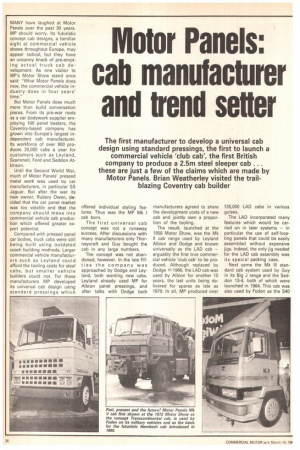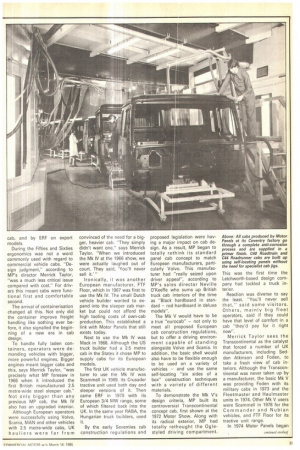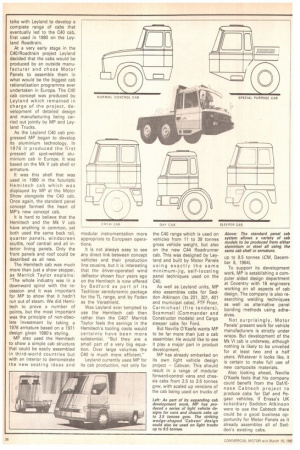Motor Panels: cab manufacturer and trend seller
Page 38

Page 39

Page 40

If you've noticed an error in this article please click here to report it so we can fix it.
The first manufacturer to develop a universal cab design using standard pressings, the first to launch a commercial vehicle 'club cab', the first British company to produce a 2.5m steel sleeper cab ... these are just a few of the claims which are made by Motor Panels. Brian Weatherley visited the trailblazing Coventry cab builder
MANY have laughed at Motor Panels over the past 30 years. MP should worry. Its futuristic concept cab designs, a familiar sight at commercial vehicle shows throughout Europe, may appear radical, but they have an uncanny knack of pre-empting actual truck cab development. As one visitor to MP's Motor Show stand once said: ''What Motor Panels does now, the commercial vehicle industry does in four years' time."
But Motor Panels does much more than build conversation pieces. From its pre-war roots as a car bodywork supplier employing 160 panel beaters, the Coventry-based company has grown into Europe's largest independent cab manufacturer. Its workforce of over 900 produces 20,000 cabs a year for customers such as Leyland, Scammell, Ford and Seddon Atkinson.
Until the Second World War, much of Motor Panels' pressed metal work was used by car manufacturers, in particular SS Jaguar. But after the war its new owner, Rubery Owen, decided that the car panel market was too volatile and that the company should move into commercial vehicle cab production which offered greater export potential.
Compared with pressed panel car bodies, truck cabs were still being built using outdated coach building methods. Larger commercial vehicle manufacturers such as Leyland could afford the tooling costs for steel cabs, but smaller vehicle builders could not. For these manufacturers MP developed its universal cab design using standard pressings which offered individual styling features. Thus was the MP Mk I cab born.
The first universal cab concept was not a runaway success. After discussions with many manufacturers only Thorneycroft and Guy bought the cab in any large numbers.
The concept was not abandoned, however. In the late Fifties the company was approached by Dodge and Leyland, both wanting new cabs. Leyland already used MP for Albion panel pressings, and after talks with Dodge both manufacturers agreed to share the development costs of a new cab and jointly own a proportion of the tooling.
The result, launched at the 1958 Motor Show, was the Mk II cab range used by Leyland Albion and Dodge and known universally as the LAD cab — arguably the first true commercial vehicle 'club cab' to be produced. Although replaced by Dodge in 1966, the LAD cab was used by Albion for another 10 years, the last units being delivered for spares as late as 1979. In all, MP produced over 135,000 LAD cabs in various guises.
The LAD incorporated many features which would be carried on in later systems — in particular the use of self-locating panels that could be easily assembled without expensive jigs. Indeed, the only jig needed for the LAD cab assembly was its special packing case.
Next came the Mk III standard cab system used by Guy in its Big J range and the Seddon 13-4, both of which were launched in 1964. This cab was also used by Foden as the S40
cab, and by ERF on export models.
During the Fifties and Sixties ergonomics was not a word commonly used with regard to commercial vehicle cabs. "Design judgment," according to MP's director Merrick Taylor, "was a much less critical issue compared with cost." For drivers this meant cabs were functional first and comfortable second.
The arrival of containerisation changed all this. Not only did the container improve freight handling like nothing ever before, it also signalled the beginning of a new era in cab design.
To handle fully laden containers, operators were demanding vehicles with bigger, more powerful engines. Bigger engines meant bigger cabs and this, says Merrick Taylor, "was precisely what MP foresaw in 1966 when it introduced the first British manufactured 2.5 metre-wide steel sleeper cab." Not only bigger than any previous MP cab, the Mk IV also has an upgraded interior.
Although European operators were successfully using Volvo, Scania, MAN and other vehicles with 2.5 metre-wide cabs, UK hauliers were far from convinced of the need for a bigger, heavier cab. "They simply didn't want one," says Merrick Taylor. "When we introduced the Mk IV at the 1966 show, we were actually laughed out of court. They said, 'You'll never sell it.' " Ironically, it was another European manufacturer, FTF Floor, which in 1967 was first to use the Mk IV. The small Dutch vehicle builder wanted to expand into the sleeper cab market but could not afford the high tooling costs of own-cab production. This established a link with Motor Panels that still exists today.
Next to use the Mk IV was Mack in 1968, Although the US truck builder had a 2.5 metre cab in the States it chose MP to supply cabs for its European models.
The first UK vehicle manufacturer to use the Mk IV was Scammell in 1969. Its Crusader tractive unit used both day and sleeper versions of it, Then came ERF in 1970 with its European 3/4 MW range, some of which filtered back into the UK. In the same year RABA, the Hungarian truck builders, used it.
By the early Seventies cab construction regulations and proposed legislation were having a major impact on cab design. As a result, MP began to totally rethink its standard panel cab concept to match European manufacturers, particularly Volvo. This manufacturer had "really seized upon driver appeal", according to MP's sates director Neville O'Keeffe who sums up British truck cab interiors of the time as "Black hardboard in standard — red hardboard in deluxe models".
The Mk V would have to be a true "eurocab" — not only to meet all proposed European cab construction regulations, but to offer a driving environment capable of standing alongside Volvo and Scania. In addition, the basic shell would also have to be flexible enough to be used on a variety of vehicles — and use the same self-locating "six sides of a box" c:onstruction techniques with a variety of different materials.
To demonstrate the Mk V's design criteria, MP built its controversial Transcontinental concept cab, first shown at the 1972 Motor Show. Along with its radical exterior, MP had totally rethought the Oglestyled driving compartment.
This was the first time the Letchworth-based design company had tackled a truck interior.
Reaction was diverse to say the least. "You'll never sell that," said some visitors. Others, mainly big fleet operators, said if they could have that level of comfort in a cab "they'd pay for it right now".
Merrick Taylor sees the Transcontinental as the catalyst that forced a number of UK manufacturers, including Seddon Atkinson and Foden, to take a fresh view of cab interiors. Although the Transcontinental was never taken up by a manufacturer, the basic Mk V was providing Foden with its military cabs in 1973 and the Fleetmaster and Haulmaster units in 1974. Other Mk V users were Scammell in 1978 for the Commander and Nubian vehicles, and FTF Floor for its tractive unit range.
In 1974 Motor Panels began talks with Leyland to develop a complete range of cabs that eventually led to the C40 cab, first used in 1980 on the Leyland Roadtrain.
At a very early stage in the C40/Roadtrain project Leyland decided that the cabs would be produced by an outside manufacturer and chose Motor Panels to assemble them in what would be the biggest cab rationalisation programme ever undertaken in Europe. The C40 cab concept was produced by Leyland which remained in charge of the project, development of detailed design and manufacturing being carried out jointly by MP and Leyland Trucks.
As the Leyland C40 cab progressed MP began to develop its aluminium technology. In 1976 it produced the first pressed all spot-welded aluminium cab in Europe. It was based on the Mk V cab shell or armature.
It was this shell that was used in 1980 in the futuristic Hemitech cab which was displayed by MP at the Motor Show alongside the C40 cab. Once again, the standard panel concept formed the heart of MP's new concept cab.
It is hard to believe that the Hemitech and the Mk V cab have anything in common, yet both used the same back rail, quarter panels, windscreen scuttle, roof cantrail and all interior lining panels. Only the front panels and roof could be described as all new.
The Hemitech cab was much more than just a show stopper, as Merrick Taylor explains: "The whole industry was in a downward spiral with the recession and it was important for MP to show that it hadn't run out of steam. We did Hemitech to prove a number of points, but the most important was the principle of non-obsolete investment by taking a 1976 armature based on a 1971 design given 1980's styling.
MP also used the Hemitech to show a simple cab structure that could be easily assembled in third-world countries but with an interior to demonstrate the new seating ideas and modular instrumentation more appropriate to European operations.
It is not always easy to see any direct link between concept vehicles and their production line cousins, but it is interesting that the driver-operated wind deflector shown four years ago on the Hemitech is now offered by Bedford as part of its Techliner aerodynamic package for the TL range, and by Foden as the Varashield.
Was Leyland ever tempted to use the Hemitech cab then rather than the C40? Merrick Taylor feels the savings in the Hemitech's tooling costs would certainly have been more substantial. "But they are a small part of a very big equation. Over large volumes the C40 is much more efficient."
Leyland currently uses MP for its cab production, not only for the C40 range which is used on vehicles from 11 to 38 tonnes gross vehicle weight, but also on the new C44 Roadrunner cab. This was designed by Leyland and built by Motor Panels using exactly the same minimum-jig, self-locating panel techniques used on the C40.
As well as Leyland units, MP also assembles cabs for Seddon Atkinson (its 201, 301, 401 and municipal cabs), FTF Floor, Carmichael (fire tenders), Scammell (Commander and Constructor models) and Cargo sleeper cabs for Ford.
But Neville O'Keefe wants MP to be far more than just a cab assembler. He would like to see it play a major part in product development.
MP has already embarked on its own light vehicle design project — Cabvan. This should result in a range of modular forward-control vans and chassis cabs from 2.5 to 3.5 tonnes gvw, with scaled up versions of the cab being used on trucks of
up to 9.5 tonnes (CM, December 8, 1984).
To support its development work, MP is establishing a computer aided design department at Coventry with 18 engineers working on all aspects of cab design. The company is also researching welding techniques as well as alternative panel bonding methods using adhesives.
Not surprisingly, Motor Panels' present work for vehicle manufacturers is strictly under wraps. But development of the Mk VI cab is underway, although nothing is likely to be unveiled for at least two and a half years. Whatever it looks like, it is certain to make full use of new composite materials.
Also looking ahead, Neville O'Keefe feels that his company could benefit from the Daf/Enasa Cabtech project to pioduce cabs for Daf and Pegaso vehicles. If Enasa's UK subsidiary Seddon Atkinson were to use the Cabtech there could be a good business opportunity for Motor Panels as it already assembles all of Seddon's existing cabs.




















































































